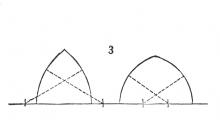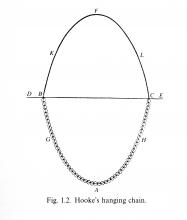The Pointed Arch
According to the principle defined by Robert Hooke, a British 18th-century physicist, the line of force in an arch will follow the line of a catenary arch--like a hanging chain (see the third image below). Since the pointed arch comes closer to the round arch to a catenary curve it is more efficient.
The accompanying diagrams are from Viollet-le-Duc's Dictionnaire and Jacques Heyman, The Stone Skeleton, Cambridge, 1995. The image on the right below illustrates the line of force in the masonry of a rounded arch: it will want to push outwards as "thrust" at the base of the arch. As the supports open outward the arch begins to sag, cracking on the inside surface at its crown and on the exterior surface at its haunch. This kind of deformation affected Amiens Cathedral in the area of the crossing, reaching a crisis point in 1497 when iron chains were inserted in the triforium to arrest further deformation. A contemporary document reveals that the builders were well aware of the existence of "thrust" in the arcade arches--it is termed boutture.



